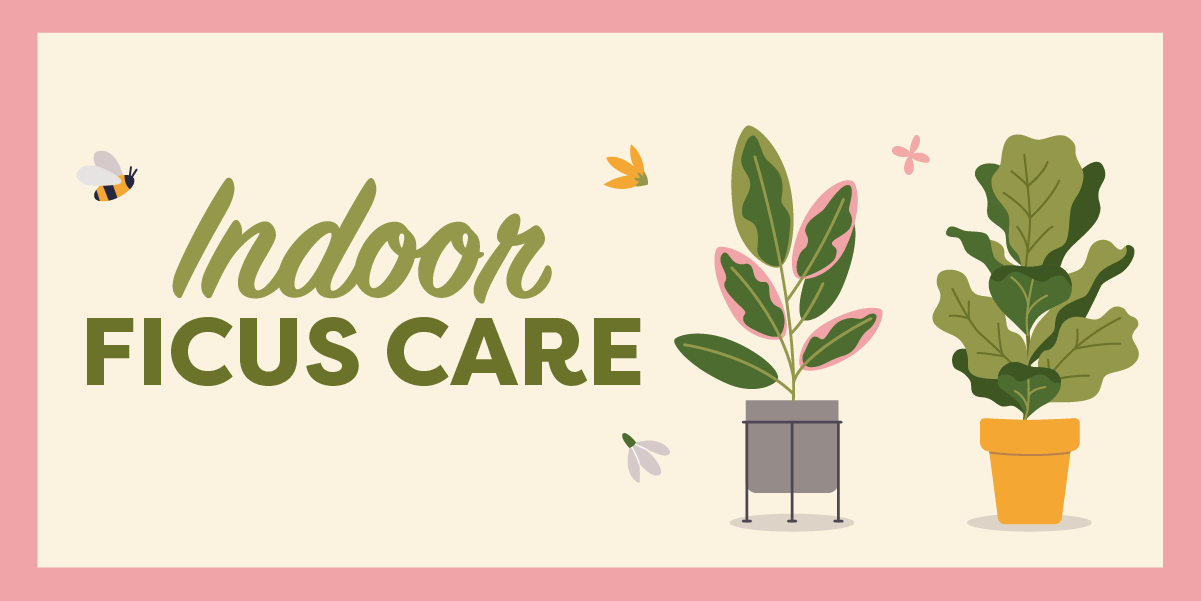A long-time favorite for interior foliage, Ficus (fig) comes in many varieties, from large specimens to accent plants of various sizes.
The Ficus genus contains 800 species of tropical and subtropical plants. Growth habits vary significantly between varieties.
From weeping, small-leaved trees to large-leaved, erect bushes, we list below the Ficus varieties we consider best for indoor use.
Like any plant, your Ficus needs time to adapt to the home environment. It will drop leaves at first, but this should stop once the plant is acclimated.
Soil
For optimal growth, indoor ficus plants require well-draining soil.
- Type: A high-quality, all-purpose potting mix that retains moisture and allows for adequate drainage.
- pH Level: Slightly acidic to neutral, with a pH range of 6.0 to 7.0.
- Composition: Incorporate organic matter like peat moss or compost to improve soil structure and nutrient content.
- Additives: Mix in perlite or sand to enhance aeration and prevent soil compaction.
- Moisture: Keep soil moist but not soggy.
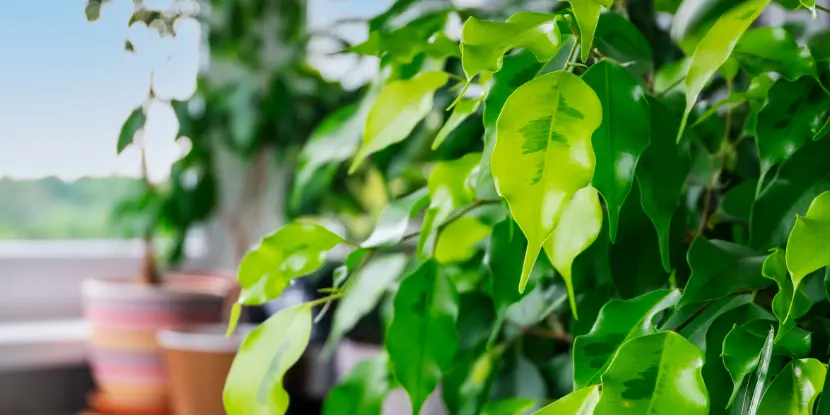
The lush foliage of the Ficus benjamina plant.
Sunlight
- Bright, indirect light is ideal. Choose a spot near a window with filtered sunlight.
- Avoid direct sunlight, which can scorch the leaves, especially during the hottest part of the day.
- Ficus plants can adapt to lower light conditions, but this may slow their growth and reduce the luster of their foliage.
- Try to maintain consistent lighting conditions. Sudden changes in light exposure can stress the Most Ficus varieties prefer high humidity levels.
- If the air in your home is dry, use a humidifier or place a water tray near the plant to increase humidity.
- Alternatively, you can mist the leaves regularly with room temperature water.
Humidity
- Most Ficus varieties prefer high humidity levels.
- If the air in your home is dry, use a humidifier or place a tray of water near the plant to increase humidity.
- Alternatively, you can mist the leaves regularly with room temperature water.
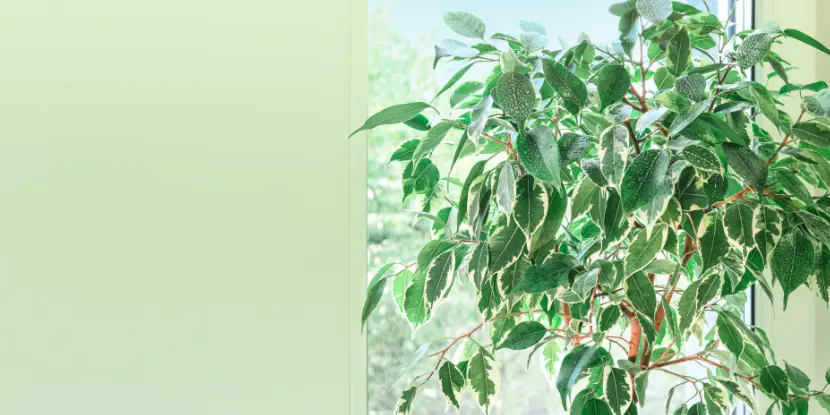
Place your Ficus plant near a window with strong, filtered sunlight.
Watering Ficus
- Over-watering is one of the most common mistakes when caring for indoor Ficus plants.
- Water the plant when the top inch of soil is dry.
- Water thoroughly, allowing excess water to drain out of the bottom of the pot.
- Use room-temperature water to avoid shocking the plant’s roots. Pour water slowly and evenly over the soil surface.
- Don’t let the plant sit in standing water, which can lead to root rot and other issues.
- Purchase a moisture meter if you’re uncertain about the soil’s moisture level.
- Your Ficus may need more frequent watering during the growing season (spring and summer). Conversely, watering should be reduced during the plant’s dormant period in fall and winter.
Temperature
- Ficus plants prefer temperatures between 60°F to 75°F (15°C to 24°C).
- They tolerate slightly cooler temperatures, but sudden drops below 50°F (10°C) can cause leaf drop.
- Keep your plant away from cold drafts or heaters, which can also affect its growth and health.
Fertilizing Ficus
- Use a balanced liquid fertilizer once a month during spring and summer.
- Dilute the fertilizer to half-strength. Too much can cause leaf burn and other issues.
- Reduce or suspend fertilizing during the plant’s dormant period, usually in late fall and winter.
- Over-fertilizing during dormancy can harm the plant.
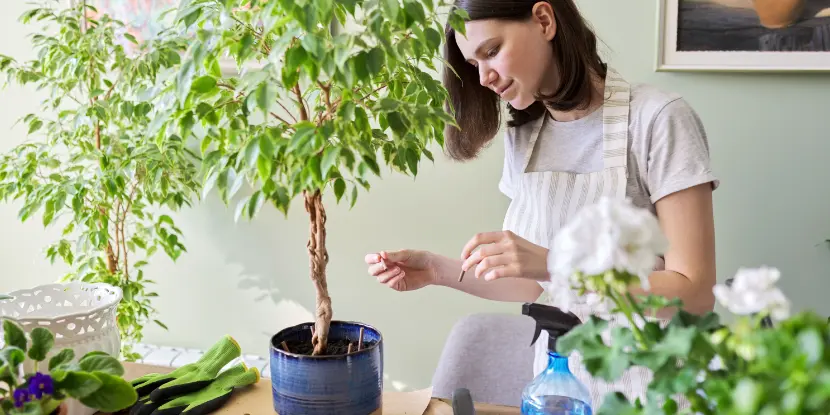
A young woman fertilizes a potted Ficus plant.
Fertilizing Ficus
- Use a balanced liquid fertilizer once a month during spring and summer.
- Dilute the fertilizer to half-strength. Too much can cause leaf burn and other issues.
- Reduce or suspend fertilizing during the plant’s dormant period, usually in late fall and winter.
- Over-fertilizing during dormancy can harm the plant.
Controlling Insects & Diseases
If your Ficus shows signs of wilting, discolored leaves, or stunted growth, it may be affected by insects or diseases. Look for common pests like spider mites, scale, or aphids, which cause visible damage to leaves and stems. Fungal or bacterial infections might present as spots or lesions on the foliage.
Insects
- Apply systemic granules to the soil as a preventative insecticide.
- Apply neem oil as a natural pesticide. It disrupts insects’ life cycles, preventing them from feeding and reproducing.
- Use insecticidal soap sprays to suffocate soft-bodied insects such as aphids and whiteflies. These soaps are effective and safe for most plants.
- Sprinkle diatomaceous earth around the plant’s base. This natural powder dehydrates and kills crawling insects without harming the plant.
- Mix garlic or hot pepper with water to create a spray. Spray this on the foliage to repel insects.
- Remove the plant from its pot and wash off all the soil for severe infestations. Use a strong water spray to loosen any pests or eggs attached to the roots. Repot in fresh soil and treat it with an insecticide before returning it to its original location.
Diseases
- Reduce humidity levels to prevent fungal infections.
- Remove diseased foliage promptly and isolate the plant to prevent spreading.
- Use a fungicide spray or neem oil to treat fungal diseases like leaf spot, powdery mildew, and rust.
- Treat bacterial infections with a copper-based fungicide spray.
- Improve air circulation and avoid over-watering, which can increase the risk of developing fungal or bacterial infections.
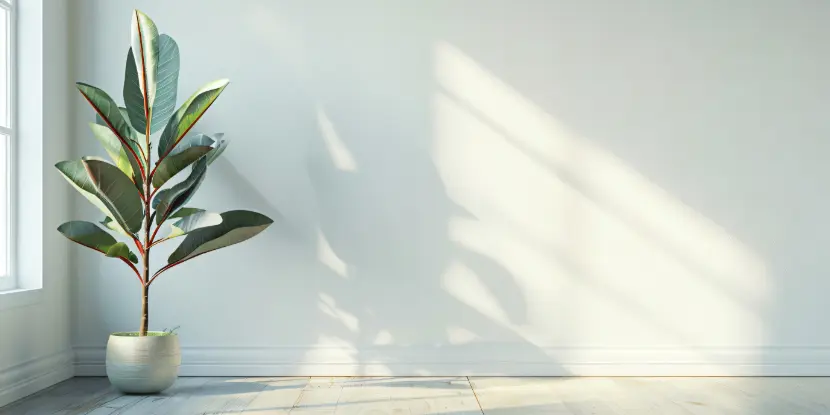
A small rubber basking in indirect light.
Repotting Ficus
- Repot your indoor Ficus every 1–2 years, depending on its growth rate and the size of the current pot. Younger ficus plants might require more frequent repotting than mature ones.
- The best time to repot is early spring, just before the growing season begins. Repotting during this period allows the plant to recover and establish roots in the new soil quickly.
- Signs that your Ficus needs repotting include roots growing out of the drainage holes, soil dries out too quickly, or a plant that appears top-heavy or is lifting itself out of the pot.
Changing Potting Soil
- It’s important to refresh the soil even if you’re not changing the pot. Aim to replace the top few inches of soil every 6–12 months to replenish nutrients and improve soil aeration.
- Remove the top layer of old soil and replace it with a fresh, high-quality potting mix. Avoid disturbing the roots during this process.
Additional Care Considerations
- Regular pruning helps maintain the Ficus’s shape and prevents it from becoming leggy. To improve air circulation, trim off dead or yellowing leaves and thin out overcrowded branches.
- Regularly dust the leaves of your Ficus to allow for better photosynthesis and a cleaner appearance. Use a damp cloth to gently wipe both sides of each leaf.
- Keep your Ficus away from pets and children. The sap of some Ficus varieties can cause skin irritation or stomach upset if ingested.
- Avoid applying leaf shine products, which can clog the plant’s pores and prevent it from properly absorbing air and light.
- Propagate your Ficus by taking stem cuttings during the growing season. Dip the end of a 4–6 inch cutting into rooting hormone and plant it in a pot filled with moist soil. Keep the cutting in a warm and humid environment until roots form.
If you need help finding the best way to care for your Ficus, consult with an Anawalt plant specialist or join an online community of fellow Ficus enthusiasts. There’s always more to learn about these fascinating and beautiful plants!
Popular Ficus Varieties & Their Characteristics
Most of the following ficus varieties require bright, filtered light.
Council Tree
- Ficus altissma
- From the Malay Archipelago and Philippine Islands
- Strong, filtered light
- Broad, flat, oval leaves 6 inches or more in length
- Forms a spreading head and gives a coarse texture. A popular form is variegated.
- It can get very large under ideal conditions. It’s a great patio plant, too!
Benjamin Fig
- Ficus benjamina
- From the Malay Peninsula
- Strong filtered light
- Most popular of all indoor specimens.
- Weeping branches drape from a symmetrical dense head. Finely textured, glossy green foliage.
- Takes pruning well. Benjamina often will drop 50% of its leaves when moved but can replace all leaves in 6 weeks.
- Older plants often have aerial roots.
- Many new forms, including those with twisted, tiny, or variegated foliage, are now available.
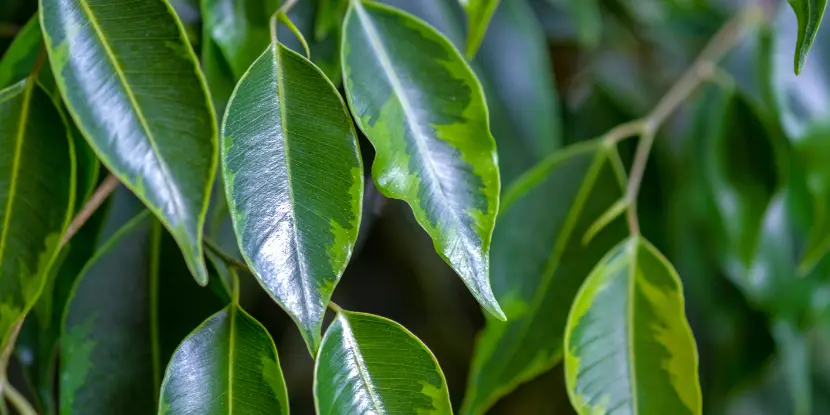
Close up of the smooth, bright leaves of the Weeping Fig (Ficus benjamina).
Weeping Ficus
- Ficus benjamina Var. nuda (syn. Ficus stricta)
- From the Malayan peninsula
- Strong, filtered light
- Extreme weeping habit
- Large leaves and satiny gray trunk make this Ficus highly desirable for indoors.
- Holds up well in medium light
Wintergreen Ficus
- Ficus ‘Wintergreen’
- Selected cultivar
- A new variety is grown in tissue culture for uniformity.
- Larger leaves and upright habit make this Ficus popular for interior landscaping.
Mistletoe Ficus
- Ficus deltoidea (syn. F. diversifolia)
- From the Malay Archipelago
- Shrubby species, ideal for a tabletop ficus
- The plant produces many berries resembling mistletoe. Leaves are triangular in shape and small: 1 – 3 inches long
Rubber Plant
- Ficus elastica
- From India and Malaya
- Leaves are up to 12 inches long and about 1/2 as wide.
- Oblong glossy foliage
- Prominently featured on the rubber plant are large, rose-pink stipules that envelop the leaf buds until they open
- Also available in variegated and burgundy forms
Fiddleleaf Fig
- Ficus lyrata
- From tropical Africa
- Fiddle-shaped leaves up to 15 inches long and almost as wide
- Lyrata bark is rough and dark brown, giving it a mottled appearance
- Usually sold as an upright growing to 4 to 8 feet
Sabre Leaf Fig
- Ficus macclendenii
- From Hawaii
- Long, pointed, dark green leaves
- Will tolerate somewhat lower light than other ficus species.
- Has a rather wild, informal look
“Bonsai” Ficus
- Ficus nerifolia
- From Himalaya
- A small tree usually seen as a Bonsai candidate.
- Very narrow leaves to 2 to 3 inches long when grown as a Bonsai; much larger leaves otherwise
Indian Laurel
- Ficus retusa
- From the Malay Peninsula
- Non-weeping tree with stiff, blunt foliage
- Produces fewer aerial roots than Benjamina
- Leaf drop is not a problem with retusa, which tends to hold up better indoors
- Also has a variegated form
FAQs: Caring for Indoor Ficus
Q: What’s the ideal lighting for indoor Ficus?
Indoor Ficus plants thrive in bright, indirect sunlight. Place them near a window where they’ll receive plenty of light but aren’t directly exposed to the harsh midday sun.
Q: How often should I water my Ficus plant?
Water your Ficus when the top inch of soil feels dry. This typically means watering once a week but can vary depending on the humidity and light in your home.
Q: What type of soil is best for Ficus?
Choose a well-draining potting mix. Consider adding perlite or sand to improve drainage.
Q: Do I need to fertilize my indoor Ficus?
Feeding your Ficus with a balanced, water-soluble fertilizer every 4-6 weeks during the growing season (spring and summer) can promote health and growth.
Q: Why are the leaves on my Ficus dropping?
Leaf drop can be a sign of stress due to overwatering, under-watering, or sudden changes in temperature or light. Evaluate your care routine and environment to identify and correct the cause.
Q: How can I increase humidity for my indoor Ficus?
Place a humidifier nearby, set your plant on a tray of pebbles with water, or mist the leaves regularly.
Q: What temperature is best for my Ficus?
Ficus plants prefer temperatures between 60-75°F (15-24°C) and should be protected from drafts and extreme temperature changes.
Q: How should I prune a Ficus plant?
Prune your Ficus sparingly to shape the plant or remove dead or overgrown branches. Always use sharp, clean shears and cut just above a leaf node.
Q: Can Ficus plants be repotted, and if so, how often?
Ficus should be repotted every 2-3 years, ideally during the spring. Choose a pot slightly larger than the current one, and ensure it has adequate drainage.
Q: What pests commonly affect Ficus plants, and how can I treat them?
Common pests include spider mites, mealybugs, and scale insects. Treat infestations with insecticidal soap or neem oil. Isolate the affected plant to prevent spreading.

